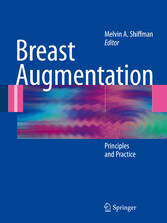Suchen und Finden
Initial Consultation (p. 69-70)
Melvin A. Shiffman
10.1 Introduction
The initial consultation with a patient considering breast augmentation should be complete. The patient will be impressed if a proper history and examination are performed and will be more likely to schedule the surgery. Enough information from the patient should be requested to be able to evaluate whether or not to perform the surgery.
10.2 Subjective Reasons for Breast Augmentation
The patient is the only one to decide whether augmentation is necessary. Surgeons should avoid the patient who has a body dysmorphic disorder and is seeking a surgery that may minimally, if at all, improve the body. This becomes more important when revision may be necessary. Very minor corrections should be avoided. A significant number of patients will need surgical correction of the augmentation for asymmetry, contracture, ptosis, infection, or necrosis. The more breast surgeries performed on a patient, the more likely the complications.
10.3 History
The patient’s past history should be obtained, at least including past surgeries of the breast and chest, bleeding or bruising tendencies, pulmonary or heart disorders, and prior thromboembolism. The date of her last menstrual period should be requested.. Medications being taken should be listed, including aspirin, Coumadin, nonsteroidal anti-inflammatory drugs, estrogen, and herbals. If the patient presently smokes cigarettes, this may impact wound healing and may cause necrosis. A history of diabetes mellitus is important because uncontrolled diabetes increases the risk of slow healing and wound infection. The surgeon should have an internist check the blood sugar preoperatively and follow blood sugar on a daily basis for at least 7 days postoperatively and then on a regular basis.
history of breast cancer should be taken very seriously. The patient should have a checkup by the oncologist to make sure that metastases have not occurred, and recent mammogram report should be obtained or a mammogram ordered to make sure there are no suspicious areas in either breast. If lumpectomy has been performed followed by radiation, there is a reasonable assumption that the breast tissues have a decreased blood supply from the radiation. Therefore, healing will slower, and there is a greater risk of necrosis. Incisions near the area of the incision site for the lumpectomy, where increased radiation has been used, should avoided because healing will be very prolonged, and chance of wound breakdown increases.
The family history should include at least cancers the breast, blood dyscrasias, and thromboembolism. Patients with a strong familial history of breast cancer should be counseled about the possibility of future breast cancer and the effects of the presence of an implant in the submammary position possibly decreasing chance of early diagnosis.
10.4 Physical Examination
physical examination should include at least the heart and lungs as well as the breast and axilla. The breasts should be examined both in the sitting and supine position with the arms over the head (this flattens the breast against the chest wall). Observe the breast for skin or nipple indentations and asymmetry. Check for masses in the breast and axilla, tenderness, induration. Record the following measurements: Sternal notch and/or midclavicle to nipples Nipples to midline Extent of ptosis: either the degree and/or measurement from nipple to inframammary fold and inframammary fold to lowest point of breast
10.5 Informed Consent
Informed consent requires that the patient receive enough information about the surgical procedure proposed and the alternatives as well as the possible risks and complications of each so that a knowledgeable decision can be made.
10.6 Implants
Evaluation for implant size may be performed in the office with the use of various sizes of implants, or baggies filled with water of different amounts, placed in the brassiere and using a mirror to determine what looks best. The patient can use baggies at home in order to consider the proper size, and she can bring in photos of topless women whose appearance she desires. The surgeon should make sure that the patient decides on the size and is not influenced by her spouse or boyfriend. The patient’s own body image should be the determining factor. The surgeon and office staff should also not influence the patient as to size.
The type of implant―smooth or textured, silicone or saline―should be described along with its pros and cons. The position of the implants, above or below the muscle, should be discussed as well as the surgical incision site―axillary, periareolar, intraareolar, inframammary, and possibly the umbilical approach.
Alle Preise verstehen sich inklusive der gesetzlichen MwSt.












